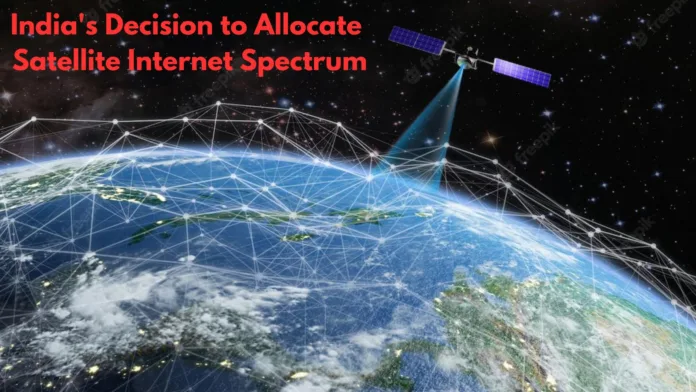Summary
- Innovative Spectrum Allocation For Satellite Internet: Examine India’s audacious proposal to transform satellite internet services by putting traditional auction techniques to the test through a proposed licensing model.
- Effects Worldwide on Telecom Giants: Recognise how India’s proposed strategy will affect international players such as OneWeb and Starlink, as it will change the competitive landscape in satellite broadband services.
- Market Protection: Examine Deloitte’s market projections, which indicate that the satellite broadband service market in India is expected to grow at a remarkable rate of 36% per year and could reach a potential value of $1.9 billion by 2030.
- Comprehensive Legislative Overhaul: Enact the Telecom Bill, 2023 to replace outdated legislation that dates back to 1885 and bring in new regulations for India’s telecommunications industry. This is part of a comprehensive legislative overhaul.
- Uncertainties and Industry Fears: Discover how the bill was analyzed critically in the article, which highlights regulatory ambiguities for Internet-based communication services and industry demands for more consultation to clarify definitions.
Table of Contents
Getting Around India’s Satellite Internet Scene
India has made a ground-breaking proposal for a licensing strategy to allocate spectrum for satellite internet services. This move has significant ramifications for important players, such as Elon Musk’s Starlink and India’s telecom behemoth Reliance Jio. It is included in the latest draft bill for the telecommunications sector.
Comprehending the Plan: A Revolution in Spectrum Distribution
The long-standing Indian Telegraph Act is to be replaced by a proposed licensing scheme that offers a substantial alternative to conventional auction procedures. For multinational companies like Starlink and Amazon’s Project Kuiper, which support streamlined procedures to hasten the deployment of satellite services, this change is unquestionably positive.

The Conflict of Views: Global Satellite Giants vs. Reliance Jio
International businesses support the suggested strategy, but India’s largest telecom company, Reliance Jio, disagrees. The disagreement centers on how spectrum should be distributed; Reliance Jio supports auctions as a means of creating fair competition in the developing market for satellite broadband services.
Market Forecasts: India’s Satellite Broadband Services’ Growth Path
As per Deloitte, the Indian market for satellite broadband administrations will develop at a shocking pace of 36% each year and reach $1.9 billion by 2030. This direction might be fundamentally molded by the recommended authorizing methodology, which would open entryways for central parts in the market like Amazon’s Kuiper, Elon Musk’s Starlink, and Bharti Airtel’s OneWeb.
Worldwide Context: Regulatory Structures and Takeaways from the 2G Example
The article explores the controversy surrounding the distribution of satellite spectrum while looking at the larger picture. It draws attention to how special the satellite spectrum is, which is regulated by the International Telecommunication Union (ITU). It highlights the unique characteristics of satellite spectrum and draws comparisons with the 2012 Supreme Court decision regarding the distribution of 2G spectrum.
Telecom Bill 2023: A Complete Revision
In addition to addressing satellite spectrum allocation, the draft Telecom Bill, which was introduced in 2023, gives the Indian government the authority to forbid or suspend the use of telecom equipment from particular nations on the grounds of national security. The more general implications and possible geopolitical repercussions are examined in this section.
Also Read: Automatic Albums Introduced By WhatsApp: Revolutionizing User Experience
Determining Authority: The Function of Government in Allocating Spectrum
The paper balances the benefits of administrative allocation versus conventional auctions as it moves through the subtleties of spectrum allocation. Readers are given a thorough grasp of the suggested strategy through the analysis of prominent players such as Reliance Jio, OneWeb, and Starlink, as well as insights from industry experts.
Legislative Framework Evolution: Replacing Laws from the Colonial Era
The Telecom Bill, which seeks to supersede antiquated legislation originating in 1885, represents a thorough reorganization of India’s telecommunications industry. This section addresses the necessity of structural changes in light of the changing environment and advances in technology.
Controlling Internet-Based Communication: Bill’s Ambiguities
The Bill’s approach to regulating Internet-based communication services is unclear when examined critically. The paper analyses the definitions and possible regulatory scope, highlighting issues brought up by trade associations and civil society.
Industry Reaction: Requests Additional Consultation
Industry associations, such as the ITI Council, which represents significant tech companies, voice concerns about the Bill’s expansive definition of telecommunication services as it develops. The industry’s request for additional consultation to ensure regulatory framework clarity and improved definitions is captured in the article.
The Changing Face of TRAI: Appointments in the Private Sector
The article centers around the Telecom Administrative Power of India (TRAI), as the need might have arisen for the arrangement of a director from the confidential area. This part gives an outline of this imperative turn of events and its potential ramifications.
Conclusion: Developing India’s Telecom Prospects
The main conclusions are summed up in the concluding remarks, which also highlight the revolutionary potential of India’s suggested strategy for allocating satellite spectrum. It emphasizes how crucial it is to have a flexible and dynamic legal framework to promote innovation and expansion in the quickly changing telecom industry.
Disclaimer:
AI was used to conduct research and help write parts of the article. We primarily use the Gemini model developed by Google AI. While AI-assisted in creating this content, it was reviewed and edited by a human editor to ensure accuracy, clarity, and adherence to Google's webmaster guidelines.


